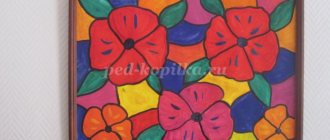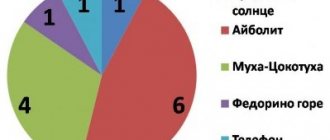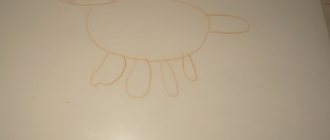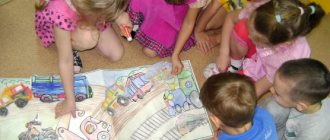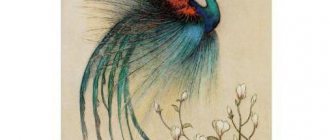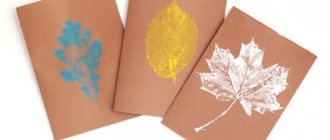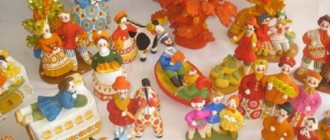Drawing on the topic “Clothes, shoes and hats” in the senior group: understanding the aspects
If in the middle preschool level the children drew clothes, shoes and hats mainly according to a ready-made template, then in the older groups they themselves draw and paint its silhouette. Children 5–6 years old already have a fairly developed sense of shape, color, and proportion. Looking at a piece of clothing, they quickly determine its shape and recreate it on a sheet of paper. In addition, they have no difficulty in drawing things from memory or from an idea.
Children of this age successfully master compositional skills: they place an object on paper according to its proportions: for example, if it is a long sundress or dress, then the sheet of paper is positioned vertically, but if the object is elongated in width (a pair of mittens), then horizontally.
The children's knowledge of basic colors is consolidated, they recognize new colors (purple) and shades (lilac, light green, etc.) and actively use them in their works. Children distinguish between dark and light tones, pale and saturated. Note that the teacher should draw the attention of preschoolers to the fact that not only multi-colored compositions look attractive, but also single-color ones (sometimes this can make the drawing more expressive). However, when drawing clothes, the teacher does not impose his opinion on the children: he gives them the opportunity to express their own preferences.
Drawing clothes, shoes and hats, although it relates to subject matter, is in fact very closely intertwined with decorative drawing: after all, kids not only depict dresses, boots, mittens, but also decorate them with a variety of, sometimes intricate, patterns. The teacher’s task is to help them achieve rhythm in the construction of the ornament.
Materials used and base
When drawing wardrobe items, we mainly use a standard base (A4 sheets of paper). When painting with paints, it is tinted in pale pastel shades. As for ready-made templates, they are offered to children only if the emphasis in the lesson is on decorating clothes with some specific pattern (for example, when depicting the clothes of the ancient Slavs or if the topic is designated “Fabric Painting”). Here, first of all, the decorative skills of preschoolers are assessed. We also note that working with templates is also more appropriate when teaching children with mental retardation.
If group work is expected, the teacher prepares a large template and the required shape in advance.
Preschoolers color the elements to their liking
A blank that several preschoolers will fill in with details
As for drawing tools, in the senior preschool level children are provided not only with colored pencils and paints (gouache and watercolor) - wax crayons and a simple graphite pencil are often used (graphic compositions).
Drawing techniques and techniques to use
In the senior group, all visual skills are further improved. The most key ones are the different positions of the pencil and brush depending on the drawing techniques. When painting large details, the tool leans more towards the paper - the strokes are wider. When drawing small elements, the brush or pencil should be held almost vertically, closer to the base. All these techniques develop ease and freedom of movement, which makes it possible to express creative imagination.
Pupils of the senior group also practice the skill of regulating pressure on a pencil. Drawing light lines makes it possible to draw a more accurate, realistic shape, adjusting it as necessary. On the other hand, clear lines are necessary to obtain intense color.
If in the middle level children depicted objects of complex shapes, dividing them into simpler component parts, now the teacher teaches them to draw a contour with one line. For this skill, you need to practice free rotation of your hand during the image process (no need to rotate the paper). This skill is developed gradually (drawing multidirectional arcs, wavy lines, curls).
When working with paints, preschoolers learn to independently obtain new colors and shades, and to lighten the color of watercolor paint by diluting it with water.
Additional types of visual activities used when drawing wardrobe items, the relevance of an individual approach
The depiction of clothes, shoes and hats is largely decorative drawing, so the use of various additional types of decoration would be very appropriate here. This can be an application using both traditional and non-traditional materials. For example, a hat drawn and colored with pencils will be decorated with paper geometric shapes, and a coat painted with gouache can be glued to real plastic buttons.
Drawing organically combines with appliqué
The appliqué elements made from fabrics look interesting in the picture. For example, the drawn girl is wearing a glued-on fur coat made of velvety material, which is decorated with paper buttons.
A fur coat made of soft fabric is pasted onto a drawn silhouette of a girl.
For decorative purposes when drawing clothes, it is quite possible to use plasticine, forming various elements of the pattern from it.
Since preschoolers in the older group already differ from each other in the level of development of artistic abilities, it is quite possible for them to individualize tasks according to the degree of complexity. A well-prepared child can be offered to decorate his drawing in any of the ways listed above, or offered another sheet of paper or a template to create a new composition (on a different level).
Specific options for compositions within the theme “Clothes, shoes and hats”
In the first half of the year (October), pupils of the senior group are invited to draw on the theme “Girl in an elegant dress.” However, here attention is paid not so much to the shape and decoration of clothing, but to the transfer of the correct proportions of the human figure. By the way, a little later, in December, the sculpture “Girl in a Winter Coat” is carried out.
It is advisable to periodically offer preschoolers images of individual items of clothing. This should be drawing according to the season (for example, in winter - mittens, a hat, coat, in autumn - a dress, in spring - a sundress). Some topics, for example those affecting the clothing of the ancient Slavs, are appropriate at any time of the year. It is advisable that drawing be preceded by an appropriate lesson to familiarize yourself with the world around you.
Drawing specific items of clothing should ideally be preceded by a lesson in decorative fabric painting, in which children decorate templates for dresses, sundresses, and sweaters with beautiful patterns. The goal of such an activity is for children to understand that materials are not only plain, but also decorated with a beautiful print.
Let us outline specific options for classes within the topic:
- "House of Models" (or "Atelier").
- “Clothes of the Slavs” (“What they wore in Rus'”).
- “Dressy boots” (“Boots for a doll”), “Felt boots”.
- “Coat for a doll” (“Fur coat for a doll”).
- "A smart dress for mom."
- “My hat” (or the “Hat and mittens” set).
- “Beautiful mittens” (“Mittens for the Snow Maiden”).
If desired, you can also organize a group project, for example, “Beautiful Warm Scarf.” Children are divided into subgroups of approximately seven people. The teacher offers each of them a large base in the form of a scarf and separate paper fragments that compose it like a puzzle. Each child paints his own element, and then they are glued to the base - you get an original multi-colored accessory.
The accessory is made up of separate paper fragments
Another original option
What nuances are taken into account when preparing a lesson on drawing clothes?
The goals of depicting clothing, shoes and hats in the older group are:
- acquaintance with the history of the development of costume, as well as the features of folk elements in clothing,
- working with templates and creating your own sketches of wardrobe items,
- explanation of the rules for choosing clothes for different seasons, life situations (on the occasion of a celebration - bright, festive, for a walk - casual, etc.),
- enriching knowledge regarding professions related to the creation of clothing (shoemakers, fashion designers, tailors, cutters, etc.),
- nurturing a sense of proportion and harmony when selecting decorative elements of a costume.
Drawing clothes gives children the opportunity to choose their own color schemes for coloring, and then evaluate the result from the point of view of aesthetics
What is needed for the lesson
Wardrobe items are usually depicted on sheets of standard white A4 paper. An important nuance: if the drawing is intended to be painted, then the sheet should be tinted only with pale pastel colors. The image will be “lost” on a bright background. If the drawing is supposed to be decorative, then you can use ready-made templates, which the guys paint in accordance with the assignment. For example, Slavic patterns of folk costume in the theme “Fabric Painting”.
Drawing is an important activity for children with mental retardation. However, due to limited capabilities, such children may not be able to create a drawing “from scratch,” so the teacher actively involves working with templates that need to be painted, decorated, or supplemented with missing lines, for example, to complete the top line for the crown of a hat.
For drawing in the senior group on the topic “Clothes, shoes and hats”, as well as for other topics, colored pencils, paints (watercolor and gouache with richer shades), wax crayons, felt-tip pens are used to create bright images, and also a simple pencil for sketching or graphic composition. For example, as part of the “Model House” theme, children sketch summer/winter/autumn-spring costumes in pencil.
In the older group, children themselves can prepare the materials and tools necessary for work
Drawing clothes and other isotechnics
Involving other visual techniques in drawing clothes is one of the methods for implementing an individual approach. Since the theme also includes decorative painting, the selection of decorations is very appropriate. So, a hat can be decorated with a geometric pattern of cut out paper figures. Not only paper, but also fabric applique will look harmonious. For example, a felt coat with paper buttons in addition to a drawn hat.
Ribbons, buttons, and braid can also be added to the design. Interesting ideas for clothing designs based on paper construction. So, children can paint on fabric on an origami shirt.
In addition, decorative elements - the same buttons, stripes on fabric - can be made from plasticine.
Photo gallery: examples of the use of various isotechniques in drawing clothes, shoes and hats
As fashion designers, children come up with unusual decor for felt boots using paints and ribbon.
Drawing ornaments of the national costume is usually combined with appliqué on the corresponding theme
Applicative geometric shapes are the most affordable option for creating decor
Creating postcards in the form of origami shirts with drawn patterns can be timed to coincide with Defender of the Fatherland Day
Drawing a cap can be combined with fabric applique of a coat
An additional task for decorating the mittens can be to create a suitable background
Implementation of an individual approach
Individualization is based on the children’s level of drawing skills, the development of attention and memory, as well as their mood during the lesson. And if you find a task for children who show interest in the work, you can use options for additional isotechniques or instructions to tint the basis for the drawing, but for those who have difficulties, it is more difficult to individualize the learning task. This could be an assignment to color the template in warm or cool shades if the child has difficulty choosing color combinations to color. Or decorate the doll’s boot with a design of your choice, if the preschooler is not in a good mood and refuses to work together with everyone.
An individual approach is also implemented through the use of additional isotechniques in the drawing.
Techniques of classical drawing techniques in the topic “Clothes, shoes and hats”
Practicing drawing techniques is an important element of work aimed at developing fine motor skills, in particular preparing the hand for writing (!). Among the main techniques are:
- drawing lines of different lengths and frequencies, which is the main element of patterns on clothes or shoes,
- chaotic hatching, that is, done in a free direction, and then outlined by the boundaries of the contour,
- vertical hatching, usually used to convey changes in shades by varying the pressure of the pencil,
- diagonal shading to draw the texture of the fabric,
- horizontal shading, which is often used to change the position of the hand when painting,
- making dots and thin/thick lines using different methods of applying the brush (short movement with the tip of the brush for a dot, a continuous line with the tip of the bristle for a thin line, pressing with the entire bristle for thick lines).
Photo gallery: samples of clothing designs using traditional techniques
Templates are usually used to create clothing decor.
Drawing clothes also involves depicting the costumes of representatives of certain professions.
By coloring clothes, children learn to find not only color solutions, but also choose the most suitable patterns for the item.
The kids can come up with their own decor for their outfits.
Looking at the finished drawings, children draw conclusions about the most successful color combinations
Different options for applying the brush can be practiced in one drawing: thin lines on the skirt and pressing with the entire bristles for the top
Photo gallery: examples of shoe designs
An option for decorating boots could be creating a magical pair of shoes for the Snow Maiden
To decorate the doll's boots, the guys use not only paints, felt-tip pens, pencils, but also applique elements
The decor of felt boots is made on the basis of a pre-colored template
Children draw shoes with both flat soles and heels
Photo gallery: samples of designs of headdresses using traditional techniques
You can color the templates with both paints and pencils.
To create the contours of the mittens, children trace their palms with a simple pencil.
On the mittens, children can draw both symmetrical designs and parts of the same plot.
To add originality to the look, you can decorate the hat with a paper pompom.
Photo gallery: examples of national costume designs
To draw national costume ornaments, it is important to use only suitable colors
One of the options for drawing a national costume could be painting kokoshniks
You can use a gel pen to paint white shirts with red patterns.
When painting national costumes, it is important to monitor the accuracy of the lines of the ornaments
Non-traditional drawing techniques on the topic “Clothes, shoes and hats”
Non-traditional techniques in the theme are usually used to create a pattern, for example, painting a dress for mom with cotton swabs or fingers. Or using stamps, for example, for flowers from carrots cut out in the desired shape. In addition, to paint fabric, you can use spraying, when using a stick or brush, paint is shaken from a toothbrush into the boundaries of the outline.
In some cases, non-classical drawing methods can also be used to create a base. For example, for the outline of a mitten, children make an imprint of their hand, putting their thumb aside and connecting all the others.
Photo gallery: examples of drawings in non-traditional techniques
Cotton swabs are indispensable for applying dot patterns
Painting with cotton swabs and fingers can be combined with poking with a brush
The palm can be completely painted over with paint, or you can outline only the outline and then paint it
Options for topics and forms of organizing children's work
The theme of drawing clothes in the senior group can be seen in different versions throughout the entire school year. So, in October, children create outfit decorations within the framework of the theme “Girl in a smart dress.” By the way, this theme continues with another type of art activity: in December, the guys sculpt “A Girl in a Winter Fur Coat.” In each season, children draw individual items of clothing: in winter - mittens, boots, in autumn - a dress, etc.
In addition, drawing can be a way to consolidate knowledge on topics in other educational areas. For example, an image of a traditional Russian costume as part of the discussion of the topic “Clothing of the Slavs” during familiarization with the environment.
Methodists recommend that if you have study time, drawing should be preceded by tasks on painting ready-made templates. This makes it easier for children to understand that the beauty and sophistication of clothing largely depends on the print.
As for the topics of drawing classes related to clothing, shoes, and hats, these could be the following options:
- "House of Models" (or "Atelier"),
- “Clothing of the Slavs” (“What did they wear in Rus'”),
- “Dressy boots” (“Boots for a doll”),
- "Felt boots",
- “Coat for a doll” (“Fur coat for a doll”),
- "Elegant dress for mom"
- “My hat” (or the “Hat and mittens” set),
- “Beautiful mittens” (“Mittens for the Snow Maiden”).
Drawing clothes can be either an individual or a group task. One option for group work could be a drawing on the theme “A warm scarf for a friend.” The teacher divides the children into groups of 6-7 people, cuts the scarf pattern according to the number of children in the groups and distributes an element to each six/seven. Children paint their elements and assemble them into a puzzle-scarf with an unusual ornament.
For a collective drawing, one common tool is selected: paints, pencils or wax crayons
How to motivate guys
Motivational techniques at the introductory stage of the lesson allow you not only to update the children’s knowledge on the topic, but also to set them up for productive work.
Table: examples of motivational techniques in a drawing lesson on the topic “Clothes, shoes and hats”
| Motivation option | Methodological value | Examples |
| Pictures, posters | These visual options help children convey the proportionality of clothing details (for example, sleeve length, size of patterns on a folk costume, etc.) | |
| Conversations | In addition to updating background knowledge, they allow you to approach the topic heuristically. | The teacher invites the children to look at each other’s clothes and answer the questions:
|
| Before drawing on the topic “Clothing of the Slavs,” the teacher tells interesting facts from the history of costume. The newborn was swaddled in cloth from the parents' torn clothes so that the baby absorbed the best qualities of mom and dad. | ||
| Games | They unite the children with a common cause, and also help them repeat material on the topic. |
|
| Puzzles | They help to attract children's attention and switch them from one type of activity to another. | A selection of riddles about tools for sewing clothes:
|
| Poems |
| |
| Stories, fairy tales, cartoons |
| |
| Surprise moments | The task is formulated by the teacher on behalf of the “guest”: the doll, the author of the letter or the interlocutor on the phone. | Children hear crying outside the door. It turns out that this is the doll Masha, who was upset because the dresses made for her friends were dull and of the same type. The teacher invites the children to make a bright and original print on the fabric. |
Video: educational cartoon “Tralik and Roller. Cloth"
Video: cartoon “Masha and the Bear. Big Wash"
Video: cartoon fairy tale “Calico Street”
Class notes
| Author's full name | Title of the abstract |
| Savelyeva O. | “House of Models” Educational objectives : introduce preschoolers to the profession of a fashion designer, teach them to create their own clothing models based on templates, and decorate them to their liking. Developmental tasks : consolidate knowledge of wardrobe items. Educational objectives : to cultivate aesthetic taste, the ability to see beauty in the world around us. Integration of educational areas : “Artistic creativity”, “Cognition”, “Communication”, “Socialization”, “Health”. Demonstration material: attributes for the game “Atelier”, “Clothing Store”. Handouts: sheets of tinted paper according to the number of children, templates for parts of clothing, watercolors, sippy cups, brushes, coasters, napkins. Progress of the lesson: The teacher informs the preschoolers that a model house is opening in their group. The specifics of the profession of a fashion designer are discussed, the teacher talks about the people who still work in the studio. Children are encouraged to become fashion designers and create a collection of clothes for the fashion house. These can be things for all occasions: for work, leisure, sports or holiday outfits. Independent activity for preschoolers, followed by a fashion show. The teacher announces the name of each fashion designer, and he presents his outfit (tells what fabric it can be sewn from, how it is decorated). After the lesson, all work is documented in a fashion magazine. |
| Kanareikina M.L. | "Dress for Mom" (drawing with wax crayons) At the beginning of the lesson, the teacher reads poems by G. Demykina about her mother:
The children discuss the poem, as well as the question: why does mom need different outfits? The teacher invites the children to draw a festive dress with an unusual pattern for their mother. There is a discussion on the topic: what an elegant dress should look like. Children express different opinions: lush, long, with a bright pattern, “like a princess.” The teacher tells preschoolers what parts the dress consists of: bodice, skirt, collar, belt. Possible elements of the pattern are discussed: stripes, dots, circles, curls, etc. Physical education is carried out:
Children begin coloring dress templates. First, you need to circle them to create a silhouette on a sheet of paper. Along the way, the teacher explains how to draw folds on a skirt with a pencil. At the end of the lesson, the teacher invites the children to close their eyes and imagine how happy their mother was with such a wonderful gift. |
| Lapsakova V. | «Boots for cats» A toy Puss in Boots comes to the children's group and is in trouble - his favorite boots are torn. And it's cold outside. The teacher explains to the children that the cat wore his boots both in winter and in summer - so they became leaky. Children guess riddles about different types of shoes and introduce them to the cat:
The following questions are discussed: why are so many different shoes needed? Is it okay for little girls to wear heels to the party? How to choose the right shoes? The dance game “Little Legs Are Dancing” is held. Didactic game “Repair Shop” - assemble puzzles with images of boots (4 subgroups of children). The teacher invites the children to become fashion designers and come up with new beautiful boots for the cat. At the end of the work, the cat thanks the children and returns back to the fairy tale. |
| Moiseeva L.M. | “We are Slavs” At the beginning of the lesson, the teacher talks with the children about their appearance, how boys and girls differ in appearance. Pictures depicting a girl and a boy, a man and a woman, and grandparents are considered. One picture shows children in different national costumes. Children are invited to find a Russian national costume. The teacher tells the children that they are also Slavs, and today they will draw themselves in a Slavic costume. The teacher reminds children of the techniques for drawing a human figure. He asks the children to imagine themselves next to an old hut, on a green lawn. The girls are dressed in sundresses, and the boys are in wide trousers and shirts. There are bast shoes on my feet. Independent work of children. Analysis of drawings. |
Notes on drawing in the preparatory group “We are young designers”
Summary of the lesson on children's design " We are young designers " in the preparatory group
Goal: to develop in children an idea of design as a field of art in the objective world; about the value of design developments; about the structure of a specific labor process ( modeling , clothing production). Introduction to the new painting technique "frottage".
Tasks:
-Continue, generalize ideas about the connection between the labor of people employed in the same production.
— introduce children to the profession of fashion designer and its purpose.
— Introduce the work of great couturiers and designers (V. Yudashkin, V. Zaitsev).
-Introduce preschoolers to the non-traditional technique of texture drawing, frottage.
— To develop the ability to create design using the knowledge gained when performing practical tasks: decoration ( design ) of modern clothing.
-Improve shading skills, adjust pressure, select colors, strengthen the ability to create a composition.
— Develop the skills necessary for collective creativity, communication skills, observation, creativity, aesthetic taste.
-To develop the ability to bring the job started to completion, to work in a team. Arouse interest in non-traditional visual material and a desire to act with it. — Foster respect for the work of adults.
Material and equipment: pictures depicting great couturiers and designers -V . Zaitsev and his clothing collection, V. Yudashkin and his collection of designer clothing . A box with spools of thread, a tape measure, scissors, needles, chalk, a thimble, a small sewing machine, a piece of fabric, a pattern, a finished dress. Sketches of clothes on A 4 paper, wax crayons, soft colored pencils, various textures for placing under paper, samples of ready-made patterns.
Progress of the lesson
Organizing time
Educator: - Look guys, today I brought a beautiful box class Let's all see what's in it together?
The teacher takes one item out of the box and asks the children to name these items (thread, tape measure, scissors, needles, chalk, thimble, fabric, small sewing machine, pattern, dress style).
Educator: - Well done! Tell me, who works with these objects, and what can be done with the help of these objects? (Children’s answers).
Educator: - List the professions that relate to tailoring? (Cutter, seamstress, tailor, fashion designer) .
Educator: - You correctly named the professions of people who are engaged in tailoring.
- I invite you to play the Question and Answer game with me.
Questions: 1. All people are wearing something, where do they buy their clothes? 2. How did the clothes get into the store? Who sewed it? 3. What are the people who sew clothes called? 4. And if you can’t find what you need in the store, where can you sew clothes? 5. In the atelier, the person who cuts the clothes will take the order. What is the name of his profession? 6. They brought fabric to the seamstress and asked her to sew a dress. Where does she start her work? 7. What should you do before cutting a dress for sewing? 8. Where does a dressmaker get clothing designs ? 9. Who comes up with clothing models ?
— Not all people can sew and design beautiful clothes. You need to study a lot and love doing it, be a dreamer, and have aesthetic taste.
All professions: seamstress, cutter, fashion designer are closely related to each other and are employed in the same production.
Educator: - You are all great and answered all the questions correctly, correctly named the professions that are involved in tailoring and talked about the function of each.
Educator: - In today's lesson Fashion Designer better .
Main part: The teacher's story.
A fashion designer (in the Russian tradition) is a specialist in making clothing models , a clothing designer , a creator of experimental samples, developing decor, choosing colors and materials, thinking through accessories and additions.
— We will now get acquainted with two famous fashion designers who were the first to win recognition and fame in the fashion industry and glorified this creative profession not only in Russia, but also beyond the borders of our Motherland.
Vyacheslav Zaitsev is a couturier, artist, poet, president of the Moscow Fashion House, member of the Union of Artists of the Russian Federation, Honored Artist of the Russian Federation. Man of the Year in the Fashion World.
Born on March 2, 1938 in Ivanovo, in a working-class family. He graduated with honors from the Ivanovo Chemical-Technological College and received a qualification as an artist in textile painting. 1962 - graduated with honors from the Moscow Textile Institute. Worked at an experimental garment factory. Now he heads the Moscow Fashion House. V. Zaitsev conducts multifaceted creative work with young artists, fashion designers and designers . Largely thanks to his efforts, Russian fashion has reached the world level, taking its rightful place . (display of a clothing collection from V. Zaitsev)
Valentin Yudashkin was born on October 14, 1963 in the village of Bakovka, Odintsovo district, Moscow region.
passion for modeling manifested itself in school. Days and nights, the future couturier drew his first “ models ” and brought them to life himself. I made patterns, sewed from everything that came to hand - for myself and for friends. After passing the final exams, there was no question for Valentin where to go to study. The news of his decision upset his parents, who believed that the profession of a fashion designer was “not for men.” In 1981, Valentin entered the Moscow Industrial College at the Faculty of Modeling . Yudashkin was not stopped by the fact that there were only girls in his “ Fashion Design ” course. It turned out that from the very first steps in his profession, Yudashkin represented the Russian fashion industry abroad, collections of his works were demonstrated in all the world’s fashion capitals, some models of Yudashkin’s dresses are in the Museum Louvre costumes. Among celebrities, he is considered the king of wedding fashion. (collection show)
I bring to your attention a collection of other fashion designers who create beautiful dresses not only for adults, but also for children.)
(showing a collection of dresses for girls)
Educator: — Did you like the unusually beautiful, exclusive design works of fashion designers ? (answers)
I'm going to open a school for young ,
Would you, girls and boys, like to go to this school (yes) I’m very glad, but first, I say without further ado
Desire alone is not enough - everyone must be ready: DRAW - DRAW, CUT AND SEW Learn quickly, and for this we all
The School of “Young Fashion Designers ” will be very useful.
Educator: - I enroll everyone in the school of “ Fashion Designers ” and before going to work, I suggest they play the outdoor game “Figure with Scarves.”
(there is a dynamic pause accompanied by musical accompaniment)
Music sounds once, Music sounds two, Music sounds three, Beautiful figure with scarves, freeze. (play 2 times)
Educator: - What beautiful movements you performed to the music, and the figures were interesting, well done.
“And now I ask you to go to school and try yourself as a fashion designer and develop a collection of clothes, and since summer is coming soon, I propose to make a summer collection called “Bright Colors of Summer.” Guys, look at your tables there are clothing models. (Skirt, shorts, dress, T-shirt) - blanks cut out of paper. Choose any model for yourself. But your models are one-color and in order for them to become designer, you need to choose a fabric for them. Now we will paint your models using a technique called frottage. Stencils for our fabric can be any objects with a corrugated surface: a regular comb, napkins, lace, tree leaves, a vegetable grater, design parts, corrugated cardboard, a mosquito net, wallpaper with a convex pattern. You need to take a stencil and place it under your sketch, select wax crayon that you like and shade the model. Using textured surfaces and colored pencils or wax crayons, you can create not only beautiful fabrics, but also original designs.
Educator: Guys, I suggest you choose stencil templates and get to work.
You need to draw carefully, do not go beyond the outline of the figure, paint each detail in one direction, hold the base, select the appropriate colors.
Independent work of children using the Frottage technique. Individual assistance for everyone.
Educator: Today you are all great! You tried very hard, you got good and interesting outfits. Let's arrange an exhibition of works. (works are hung on the board, children comment on their works, each work is discussed).
Educator: - When you become adults, maybe one of you will become a famous fashion designer , cutter or tailor.
Examples of completed student work with comments on the completion of the work
Children love to come up with their own unique patterns. The “Dress with yellow and blue ornament” is simply and tastefully designed. A blouse in an ethnic style looks stylish (drawing “Beautiful Blouse”).
Photo gallery: Fabric painting
Watercolor drawing
Watercolor drawing
Watercolor drawing
Watercolor drawing
Watercolor drawing
Pupils of the senior group create very original clothing models: tops and breeches, decorated with a golden strap, look stylish. Charming outfit – “Dress with puff sleeves.” Many young “fashion designers” have developed beautiful models of open sundresses (“Fashionable sundress”, “Sundress with fringe”). They captivate with the cheerful “Skirt and Top” colors.
Photo gallery: house of models
Watercolor drawing
Watercolor drawing
Watercolor drawing
Watercolor drawing
Watercolor drawing
Watercolor drawing
Watercolor drawing
Young artists always try very hard when they create works as gifts for loved ones. Thus, the pattern of large flowers looks very bright and attractive in the photo exhibition “Festive Dress” and “Elegant Dress”, and the “cage” print will never go out of fashion.
Photo gallery: dress for mom
Watercolor drawing
Watercolor drawing
Preschoolers love to draw mittens or color their ready-made templates. The charming pattern is composed in the composition “Beautiful Ornament”: a combination of stripes, dots, herringbones, wavy lines, chains. The mittens in the drawing “Winter Motifs” and “Mittens for the Snow Maiden” are designed in the New Year’s style. Spring motifs are presented in the work “Mittens with floral patterns.”
Photo gallery: hats and mittens
Watercolor drawing
Watercolor drawing
Watercolor drawing
Watercolor drawing
Gouache drawing
Watercolor drawing
A whole range of felt boots for every taste is presented at the photo exhibition “Favorite felt boots”. They are decorated with snowflakes, bells, other intricate flowers, cherries, and even such an unusual design as a traffic light. The children showed their creative imagination to the fullest.
And the boots at the photo exhibition “Oh, yes boots!” they look simply fabulous. We see the most intricate patterns, including even imitation lace.
Photo gallery: shoes
Watercolor drawing
Watercolor drawing
Very realistic men's shirts in ethnic style are presented in the works “Men's Shirt” and “Kosovorotka”. The sundress in the drawing “Clothes of a Slav” turned out to be charming. We see variations on the theme of the Dymkovo sundress in the compositions “Dymkovo Sundress” and “Sundress of the Dymkovo Young Lady.” A very interesting photo exhibition is presented at the stand “What did people wear in Rus'”: luxurious shawls, cute hats, and good old felt boots.
